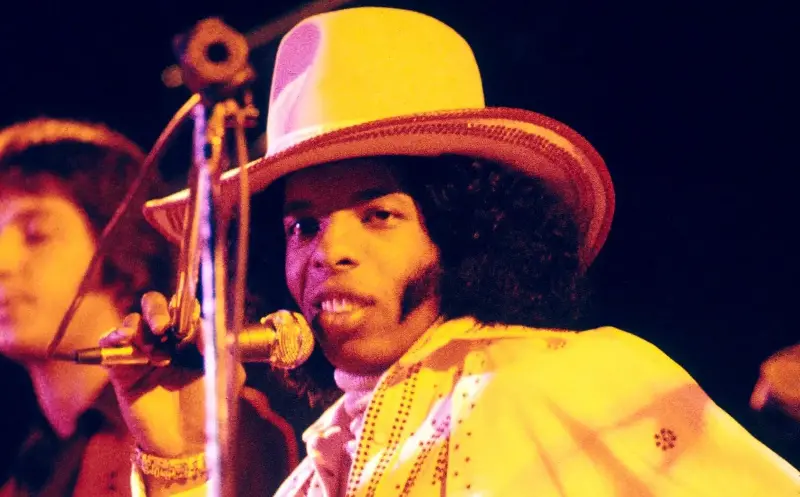
Sylvester Stewart, better known as Sly Stone, who has died aged 82, was an American singer, writer and producer who played a key role in the development of soul and popular music in the Sixties and Seventies.
With his group Sly and the Family Stone, comprised of both black and white and male and female musicians, Stone forged a pioneering hybrid of soul and rock, spiced with social commentary, which would prove critical in the development of Seventies funk music. Over a four-year period between 1968 and 1972, Stone enjoyed a string of Top 20 successes with songs such as Dance to the Music, Everyday People and Family Affair. But drug abuse, bankruptcy and a fondness for armaments would prove fatal to Stone’s career, and by the 1990s he had all but vanished from the music scene altogether and was reported to be living in a camper-van.
Sylvester Stewart was born in Denton, Texas, on March 15 1944, but grew up in Vallejo, a north-west suburb of San Francisco, where his father, KC, ran a janitorial business and was a deacon in the local Pentecostal church.
One of four children, Sylvester made his first recording aged four, singing in a family gospel group called the Stewart Four on a 78rpm single, On My Battlefield for My Lord.
A musical prodigy, who was adept at keyboards, guitar, bass and drums by the age of 11, he graduated from Vallejo High School and went on to study music theory at Vallejo Junior College, at the same time performing in a number of local groups.
In 1964 he started work as a disc-jockey on the R&B radio station KSOL, broadcasting under the moniker “Sly Stone”, a nickname acquired in high school as the result of a friend misspelling “Sylvester”.
Demonstrating the eclectic musical tastes that would mark the development of the Family Stone, Stewart deviated from the station’s format by mixing black R&B records with hits by white rock groups such as the Animals and the Rolling Stones. At the same time he worked as a talent scout and producer for Autumn records, owned by his fellow disc-jockey Tom “Big Daddy” Donahue, recording local rock acts such as the Beau Brummels and the Charlatans, as well producing a Top 10 hit in 1964 with Bobby Freeman’s C’mon and Swim.
At the same time, he founded his own band, the Stoners, which in 1966 joined forces with his brother Freddie’s band, Freddie and the Stone Souls, to become Sly and the Family Stone. Featuring Sly on keyboards and Freddie on guitar, the band also included Stone’s sister, Rose, the bass-player Larry Graham, trumpeter Cynthia Robinson and two white musicians, drummer Gregg Errico and saxophonist Jerry Martini.
The group’s first album, A Whole New Thing, released in 1967, vanished without trace. Encouraged by his record company to come up with something more commercial, Stone provided a single, Dance to the Music – an irresistibly propulsive funk-collage, in which Stone took the role of a frantic emcee introducing drums, guitar, bass, organ and brass by turn, and which gave the group their first Top 10 hit. The song would go on to be named by the Rock and Roll Hall of Fame as one of “500 Songs That Shaped Rock”, and by Rolling Stone magazine as one of the “500 Greatest Songs Of All Time”.
Inspired by the mood of San Francisco’s Summer of Love, the Family Stone provided an intoxicating bricolage of black and white styles, blending elements of the funk rhythms pioneered by James Brown with psychedelic rock, gospel choruses and Stax-style horns, complemented by their flamboyant costumes, plundered from the hippie-thread stores of Haight-Ashbury, with Stone’s flamboyant Afro coiffure, platform boots and caped and tasselled outfits lending him the appearance, as the music critic Barney Hoskins noted, of “the wildest pimp on the block”.
It was a musical and sartorial style that would turn black music on its head, influencing established groups such as the Temptations, for whom the producer Norman Whitfield provided a run of heavily Sly-influenced “psychedelic soul” hits including Cloud Nine and Papa Was a Rolling Stone, giving birth to the acid-funk of George Clinton’s Funkadelic and Parliament, and establishing a legacy that would later emerge in the work of Prince and countless hip-hop artists.
Helped by the group’s appearance at the Woodstock Festival, their third album, Stand, released in 1969, became their first to attain platinum sales, providing the multi-million selling Everyday People, a plea for unity in diversity – “different strokes for different folks/ And so on and so on and scooby dooby doo-de/ Ooh sha sha – we got to live together!”
Buoyed by his burgeoning success, in 1970 Stone moved the band from San Francisco to Los Angeles, installing himself in a mansion in Bel Air that had previously been owned by the actress Jeanette MacDonald, and latterly by the notoriously drug-addled John Phillips, of the Mamas and the Papas, and his wife Michelle. Phillips’s close friend, the producer Lou Adler, recalled that the house across the street (which had been used for exterior shots in The Beverly Hillbillies) was owned by a wealthy hotelier named Arnold Kirkeby.
“The Kirkebys were a very conservative family,” Adler said, “and they hated the flowing robes that John and his wife, Michelle, wore, the caftans and Nehru collars. They were very pleased that a ‘Mr Sylvester Stewart’ was moving in. They liked the sound of that.”
A studio was installed in the house, and fortified by copious amounts of cocaine and the animal tranquilliser PCP, and surrounded by an arsenal of guns, an entourage of heavily armed flunkies and an ill-tempered pit-bull named Gun, Stone began work on a new album.
The all-night recording sessions, with visits by everyone from Ike Turner and Miles Davis to Bobby Womack and Billy Preston, became as notorious for the atmosphere of drugged-up paranoia and dissolution as the music produced. Stone recorded many of his vocals from a prone position in his bed using a wireless microphone.
Bobby Womack would recall recording for six days before being allowed to sleep. “I was always thinking I was gonna get killed and that the feds were gonna bust in on Sly,” he told Barney Hoskins. “Everybody had pistols. It got to the point where I said: ‘I gotta get away from here.’ Sly be talkin’ to you, but he ain’t there.”
The album that emerged from the chaos, and which was finally released in November 1971, There’s a Riot Goin’ On, was an altogether denser and darker creation than Stone’s earlier work, not least because Stone had insisted on re-recording and overdubbing on the same master tape, lending the record a muffled, eerie sound.
Originally intended to be released as Africa Talks to You, the record was retitled There’s a Riot Goin’ On in response to Marvin Gaye’s album What’s Going On, which had been released a few months earlier. Described by the critic Timothy White as “a brooding, militant, savage indictment of all the decayed determinism of the 1960s”, There’s a Riot Going On went to No 1 on both pop and R&B charts within weeks of its release.
Under the influence of drugs, Stewart’s behaviour became ever more erratic. He was arrested several times for possession of cocaine, and acquired a reputation for turning up late for shows or not arriving at all. After failing to appear at one open-air festival he offered the excuse that “I must’ve been somewhere else at the time.”
At a concert in Rotterdam, the promoter felt it necessary to lock Stone in his dressing-room to ensure that the performance went ahead. Ten minutes before Stone was due on stage the promoter unlocked the door to find that the performer had broken the window and fled. Thinking on his feet, the promoter jumped in a taxi to the airport, where he found Stone boarding a flight to London, explaining: “I’m just going to do some shopping. Tell the kids it’s cool. I’ll be on time.”
Band members began to drift away. The bass player Larry Graham left in fear for his life after being told that Stone intended to kill him. In 1974 Stone married his 19-year-old girlfriend Kathy Silva on stage at Madison Square Garden before a ticket-buying audience of 21,000, with the host of the long-running television show Soul Train, Don Cornelius, presiding as MC. The couple divorced five months later.
By now, the band’s extraordinary run of successes had come to an end. The albums High On You (1975) and Heard Ya Missed Me, Well I’m Back (1976) both failed to make the Top 40, and in 1976 Stone declared bankruptcy.
Despite repeated attempts at a comeback, Stone fell into poverty. In 1984 he short-sightedly sold his publishing rights to Michael Jackson’s publishing company, Mijac Music. For many years he lived in a small “recreational vehicle” emblazoned with the slogan “Born Free”.
He became a virtual recluse, keeping such a low profile that many assumed he was dead. Sporadic comebacks failed to re-ignite his career. In 1993 he made a fleeting appearance to mark the induction of the Family Stone into the Rock and Roll Hall of Fame. An appearance at the 2006 Grammy Awards came to an abrupt end when he walked off the stage in the middle of a performance of I Want to Take You Higher, while in 2010 he was widely derided for a shambolic performance at the Coachella pop festival.
In 2007 he granted a rare interview, to Vanity Fair, conducted at a bike shop in the Napa Valley, Stone arriving on a customised banana-yellow chopper trike with a woman named Shay in full biker leathers seated on the throne-like passenger seat. The interview was cryptic to the point of opacity.
In 2015 Stone was offered a glimmer of financial hope when he was awarded $5 million in unpaid royalties, following a lengthy lawsuit against his former manager Gerald Goldstein and attorney Glenn Stone, in which Stone claimed that money he had made had been diverted away from him over a period of 11 years spanning the 1990s.
However, that ruling was later overturned on appeal, when a judge ruled that in 1989 Stone had assigned his royalties to Even St Productions in return for 50 per cent ownership in the company.
In the same year, Stone announced that he was putting together a group of albino musicians that would “neutralise all the different racial problems”, arguing that “albinos are the most legitimate minority group of all. All races have albinos. If we all realise that we’ve all got albinos in our families, it’s going to take away from the ridiculous racial tension, if you’re black or you’re white, blah blah blah.”
In 2023 Stone published his autobiography Thank You (Falettinme Be Mice Elf Agin).
Sly Stone is survived by three children, Sylvester Jnr, Sylvyette and Novena.
Sly Stone, born March 15 1943, died June 9 2025
